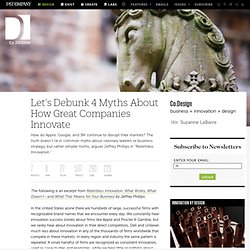

Wanna Manage The Innovation Process? Focus On Planning Scenarios, Not Fighting Fires. The following is an excerpt from Relentless Innovation: What Works, What Doesn’t--and What That Means for Your Business by Jeffrey Phillips.

Perhaps one of the biggest myths about innovation is the idea of the “lone” innovator, who works on ideas in the lab or office, without assistance or support. In this myth the innovator or inventor has a flash of insight, generates and manages ideas completely on his or her own, and fights the bureaucracy to overcome all odds to produce a commercially viable product. While these stories about individual innovators overcoming all odds are enjoyable, they are rarely true. In fact, most, if not all, ideas that become new products or services require the involvement of a significant number of people from a wide array of business functions--sales, marketing, legal, manufacturing, and distribution, to name a few.
The complexity inherent in developing, testing, and commercializing a new product demands a broad perspective and a diverse set of skills. 3 Ways To Predict What Consumers Want Before They Know It. The insight that sparks innovation appears to occur randomly.

After all, the iconic shorthand for innovation is a light bulb, implying that ideas come from sudden flashes of inspiration. While such flashes are surely good things, it is hard to depend on them, particularly if you are at a company that needs to introduce a steady stream of innovative ideas. Steve Jobs once said, “It is not the customer’s job to know what they want.” That’s absolutely right. It is yours. The quest to identify opportunities for innovation starts with pinpointing problems customers can’t adequately solve today. To discover your quarter-inch holes, obsessively search for the job that is important but poorly satisfied (for more on the underlying theory of jobs to be done, see The Innovator’s Solution by Clayton M. 1. In 2000, when A.G. Lafley is gifted at communicating complicated ideas in simple ways.
Lafley urged P&G to understand their boss as never before. 2. Consider jeans shopping. 3. Let’s Debunk 4 Myths About How Great Companies Innovate. The following is an excerpt from Relentless Innovation: What Works, What Doesn’t--and What That Means for Your Business by Jeffrey Phillips.

In the United States alone there are hundreds of large, successful firms with recognizable brand names that we encounter every day. We constantly hear innovation success stories about firms like Apple and Procter & Gamble, but we rarely hear about innovation in their direct competitors, Dell and Unilever, much less about innovation in any of the thousands of firms worldwide that compete in these markets. In every region and industry the same pattern is repeated: A small handful of firms are recognized as consistent innovators, used as case studies and examples, while we hear little or nothing about innovation in the vast majority of the other firms in those industries. Several possible factors spring to mind, including the executive management, the nature of the industry, or the capabilities of a firm’s research and development teams.
W.